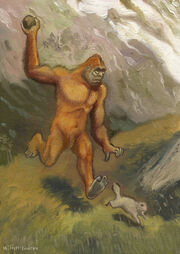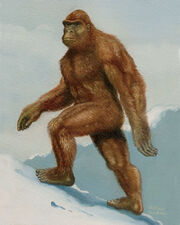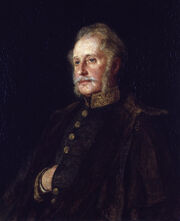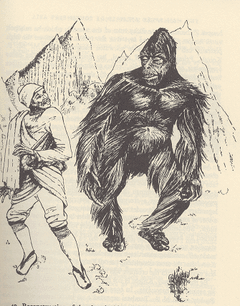| ||||||||||||||
The yeti (yet-teh; Sherpa: "that thing,"[1] "rock animal,"[2] or "small man-like animal") or the abominable snowman is a giant hominid reported primarily from the Himalayan mountains of Nepal, Tibet, China, Bhutan and India, as well as much of central Asia including Russia and Mongolia.
Three distinct varieties of yeti are commonly identified by cryptozoologists; they also include the small teh-lma, reported from warmer valleys;[3] and the generally human-like eh-Teh, though they are usually considered one and the same creature given different regional names.[2] [4] That there may be more than one type of yeti is not a fact widely known outside of cryptozoology. As Loren Coleman observes, this both explains and makes problematic the wide range of theories regarding "the yeti's identity" as "different theories may be valid with different yetis".[1]
Some of these theories, many of which have been applied to all three types, include known and unknown bears of various sizes, unknown types of monkey, a mainland orangutan or a surviving prehistoric orangutan relative, a living Gigantopithecus, and primitive human beings or misidentified hermits.[2] Sceptical theories regarding the origins of the tracks, if not made by yetis, are even more varied, including faunal and non-faunal causes.[5]
The yeti, especially under its Western pseudonym the abominable snowman, is one of the most well-known of all cryptids, alongside Bigfoot and the Loch Ness monster, and has appeared in popular culture since the first good reports in the early 20th Century. Ivan T. Sanderson adopted the term "abominable snowman" to refer to all hairy wildman-type cryptids in the world.[6]
Etymology[]
The name yeti is derived from the Sherpa word yet-teh, the meaning of which is disputed. Loren Coleman and Jerome Clark wrote in 1999 that it meant "that thing".[1] However, George Eberhart writes in Mysterious Creatures (2002) that the etymology is not truly established, and gives a number of alternative possibilities including "rock animal" (yeh: "snowy mountain" or "rocky area," teh: "animal"). Ye can be translated as "primordial" or "first," and te can also be attached to a verb to mean "when," "after," "thus," or "although," or to form a gerund ("-ing"). Others have suggested that teh may be derived from dred ("bear"). Whatever its meaning, it is said to be pronounced "yeh-tay".[2] In various places in Nepal and Tibet, the name "dremo" or "chemo" (with variation of spelling) are used for the Yeti, translating roughly to "Devil's Grandmother".[4]
The term "abominable snowman" originated in a mistranslation of the name meh-teh in 1921. During an expedition to Everest in that year, Sherpa guides working for Lieutenant Colonel C. K. Howard-Bury identified some large footprints as those of a "metoh-kangmi," as Howard-Bury wrote it. This was composed of two Sherpa words, "meh-teh" ("manlike thing that is not a man" or "man-sized wild creature") and "kang-mi," ("snow creature") and was only a generic term. When journalist Henry Newman wrote up the story for the Calcutta Statesman, he rendered the name "metch kangmi" and stated that it was a Tibetan word meaning "abominable snowman" in reference to the creature's purported strong smell.[1] The Chinese term for the Himalayan wildman is also "snowman" (xueren).[7] The term is not very widely used within cryptozoology due to its connotations; Loren Coleman refers to it as an "unfortunate appellation".[1] In an ironic refutation of the vicious image created by the name and the creature's depiction in popular culture, Bernard Heuvelmans' unpublished book on the yeti was to be entitled in English The Not So Abominable Snowman.
Description[]
Three main types of yeti are identified by Himalayan people and by cryptozoologists. The "true" yeti, the creature with a conical head said to be responsible for leaving footprints in the snow, is called meh-teh or mi-teh in Sino-Tibetan[2] and xueren (雪人; "snowman") in Chinese.[7] This yeti is described as a stocky, ape-like creature with a distinctly human quality, about the height of a young boy, with short coarse reddish-brown hair, a pointy-crowned conical head, a wide mouth with large teeth, very long arms, and no tail. Peaceful creatures, they are said to live in dense Himalayan rhododendron forests[1] at elevations of 15,000' to 18,000',[2] leaving their famous tracks when they cross the mountains from valley to valley. Bernard Heuvelmans thought the Tibetan rakshi-bompo was the same animal.[8] Edward W. Cronin proposed that the meh-teh is actually an inhabitant of valleys such as the Arun and slightly higher rhododendron forest, and that sightings and footprints in the snow are transient animals.[9]


Illustrations of the "little" and "big" yetis by Philippe Coudray.
The smaller type, sometimes called the "little yeti," is the teh-ima, and is usually said to be just 3' to 4' 6'' in height, with reddish-grey hair and a pointed, sloping head. They are said to inhabit warmer habitats than the other yetis, forested mountain valleys below the snow line in Nepal, Bhutan, Tibet, and Sikkim,[2] where they feed on small animals.[1] It has been proposed that the teh-imah is simply a juvenile or female meh-teh, and that Yeti sightings above the snowline are actually transient animals traveling between valleys.[9]
The "big yeti" is called dzu-teh, and is said to be primarily quadrupedal, though it can walk bipedally. Known for its attacks on yaks, which it kills by grabbing their horns and twisting their necks.[2][4] Similarly, the rimi, which is unambiguously ape-like, is sometimes equated with the dzu-teh[3] and sometimes considered a separate cryptid.[2]
Larger still is the nyalmo, a true giant said to be 13' to 20' high, also with an enormous conical head. They feed on yaks, mountain sheep, and possibly people, and "wander the eternal snows" of altitudes above 13,000'.[2] Heuvelmans suggested that the nyalmo may be a myth inspired by the idea that yetis get larger the higher you climb.
Physical evidence[]
Mummies[]
In 1953, a Tibetan lama called Chemed Rigdzin Dorje Lopu claimed to have examined two mummified yetis, one at a monastery in Riwoche and the other in a monastery at Sakya. He described them as:[8]
| “ | ... enormous monkeys about 2.40 m high. They had thick flat skulls and their bodies were covered with dark brown hair about 3 to 5 cm long. Their tails were extremely short.
|
” |
Investigating the mystery in the 2000's, Peter Pesavento emailed both monasteries making inquiries about the mummies. Although Sakya did not respond, Samten O'Sullivan wrote back on behalf of Riwoche, and revealed that the original monastery had been razed during the Chinese annexation of Tibet in 1950—1951, and its contents had been looted or burnt. It is not known if the Riwoche mummy was destroyed or removed.[10]
Pangboche hand[]
In 1958, the Tom Slick-F. Kirk Johnson expedition members were shown the remains of an alleged yeti hand, supposedly three centuries old, housed alongside a fake scalp at a monastery in Pangboche.
When the monks refused to let the expedition take the hand away for examination, Peter Byrne secretly substituted a handful of modern human finger and thumb bones for the corresponding bones of the Pangboche hand, wiring them into the hand, and removed the stolen finger bones to India. To get them out of the country and into the United Kingdom, Slick enlisted the aid of actor James Stewart and his wife Gloria, who were holidaying in India at the time. Knowing that the British customs of the time would not go through a lady's private garments, the Stewarts concealed the bones within the underwear packed in Gloria's suitcase, and successfully smuggled them into England.[1]
Slick showed the bones to a number of scientists including primatologist William Charles Osman Hill. While most of the scientists thought the bones could not be identified with any known primate, Hill initially thought they were of human origin, before revising his opinion and declaring that they could not be identified. Later, he changed his mind again and told Ivan T. Sanderson that the bones must have belonged to a neanderthal. The stolen finger bones were later lost.[1]
When Sir Edmund Hilary travelled to the Himalayas in 1960—1961 on the World Book Expedition, he examined what was left of the Pangboche hand and, not knowing what Byrne had done a year previous, described it as a hoax, "essentially a human hand, strung together with wire, with the possible inclusion of several animal bones." Explorers were still shown the mutilated Pangboche hand through to the early 1990s, and in 1991 an NBC-sponsored analysis of some skin from the hand found that it was of "near human" origin, as it was similar to human but not human. The following year, the entire Pangboche hand was stolen from the monastery: Coleman suggested it was sold into the international smuggled antiques trade.[1]
In 2011, the finger recovered by Peter Byrne was located in W.C. Osman Hill's collection in a box labeled "Yeti Finger". DNA tests showed conclusively that the Pangboche hand came from a human, not an unknown animal.[11] However, this DNA was later found to be that of Peter Byrne himself, not that of the finger. This is probably due to contamination when he took it from the monastery[12].
Attestations[]
1832[]

Brian Houghton Hodgson seems to have been the first person known to have mentioned the yeti in a European language, in 1832.
In 1832, James Prinsep’s Journal of the Asiatic Society of Bengal published an account by B. H. Hodgson, a trekker in Northern Nepal, in which he describes spotting a large bipedal creature covered in long dark hair. Hodgson believed it was an orangutan.[13]
| “ | "Religion has introduced the Bandar [a native monkey] into the central region, where it seems to flourish, half domesticated, in the neighbourhood of temples, in the populous valley of Nepal proper. My shooters were once alarmed in the Kachár by the apparition of a 'wild man,' possibly an ourang, but I doubt their accuracy. They mistook the creature for a càcodemon or rakshas [demons], and fled from it instead of shooting it. It moved, they said, erectly: was covered with long dark hair, and had no tail."
|
” |
1889[]
In 1899, Major Laurence Waddell released an account of his time spent in the Himalayas. In it he recounts coming across enormous footprints in the snow, which his guides attributed to a "wild man". Waddell equated the "Wild Man" as a creature of myth to the Tibetan white lion, a mythical creature whose roar is supposedly the sound of wind during a snowstorm. He believed the prints were left by the "great yellow bear", Ursus arctos isabellinus.[5][6]
1921[]
On September 22, 1921, Colonel Charles Howard-Bury set off to climb the Lahkpa pass in the early morning. During the trek they encountered a set of bizarre footprints that the porters of the expedition claimed was the trail of a "wild man", the word for which Howard-Bury rendered as "Metohkangmi", which was eventually mistranslated as "Abominable Snowman" by journalist Henry Newell. The term is actually Me-Teh Kang-Mi, translating to Man-bear Snow-Creature. Howard-Bury thought the prints were made by a loping wolf and had been distorted by melting.[14]
1925[]
Photographer N.A. Tombazi claimed to have seen a humanlike figure at around 15,000 feet in the Himalayas. Tombazi was hiking with his guides when they alerted him to the presence of the being. Though his view was initially obstructed by the reflection of the sun off of the snow, Tombazi eventually made out a human-like shape around 200 or 300 meters away, walking upright. He could make out no clothes. Tombazi watched the being pull at and uproot bushes for some time before it wandered off out of view. Investigating the site of the thing's apparition he found footprints
"...similar in shape to those of a man, but only six to seven inches long by four inches wide.... The prints were undoubtedly those of a biped."
Tombazi's guides claimed the creature was the "Kanchenjunga Demon", a feared hairy beast. Skeptical, Tombazi speculated the being was a wandering hermit or holy man, though the lack of clothes and bare feet were considered odd for such an altitude.[15][8]
Known hoaxes[]
Yeti scalps[]
During the 1950's, three alleged yeti scalps, at Pangboche, Khumjung, and Namche Bazar, attracted much attention. On 9 October 1953, the Pangboche scalp was the first to be seen by outsiders - four Indian mountaineers, Charles Evans, and Professor Fürer-Haimendorf. The lamas claimed the scalp, which was shaped like the traditional depiction of a yeti's head, was more than three hundred years old, as evidenced by the loss of hair on the top. It was photographed, and hair samples were taken and sent to experts. When a Daily Mail expedition examined and took hairs from the scalp in 1954, they also discovered a similar specimen, hairier and apparently younger, in the monastery at Khumjung; and a third scalp, in a temple at Namche Bazar, which was quickly identified as a "crude imitation" of the other two scalps. Various expeditions organised by Tom Slick, as well as a Japanese expedition from 1959—1960, removed hairs from all three scalps.[8]
Everyone who examined the Pangboche and Khumjung scalps concluded that they were single pieces of skin, with no traces of stitches or glue, and comparisons of the exported hairs with those of various other animals yielded no matches. However, not everyone was convinced of the scalps' veracity, especially in Nepal itself, and Peter Byrne, a member of Tom Slick's expeditions, wrote that "it was notorious all over southern Nepal that the Khumjung scalp was a fake and had been made some twelve to fifteen years before by a Tibetan taxidermist" out of jealousy of the lamas at Pangboche. Hausman believed the scalps were made out of a moulded and sewn skin from some normal animal, and Wood Jones maintained, correctly as it later turned out, that the hairs came from the shoulder of an ungulate.[8]
In November 1960, Sir Edmund Hilary was given permission to take the Khumjung scalp to experts in Chicago, Paris, and London, including cryptozoologist Bernard Heuvelmans, who had already examined photographs of the Pangboche and Khumjung scalps. Initially, a closer examination of the scalp showed that it had "every appearance of being genuine," due to the arrangement of the hair tracts, an arrangement found only on the crown of the head. However, able to see the skin up close, he was also reminded of the mane of the southern serow (Capricornis sumatraensis), which he had seen in the Amsterdam Zoo prior to the Second World War, and which has a relative (Capricornis thar) found in Nepal. It was a very rare animal, not represented in the Paris Natural History Museum, and its hairs had therefore not been available for comparision to the scientists who had examined the scalp hairs. Eventually Heuvelmans found a specimen in Brussels, and by comparing its hair with those on the scalps, found that the alleged scalp was indeed composed of serow hair: the scalps "were more like wigs made by stretching the skin from the neck of the Nepalese serow over a mould." The arrangement of the hair tracts, which had seemed to suggest the skin came from the crown of a head, was explained by Ivan T. Sanderson, who discovered after some experimentation that "if a moistened pelt is much stretched over a hat-shaped mould it produces a sort of 'land-slide' in the layers of skin. The hair tracts no longer lie at their original angle, but point in the direction in which the skin has been stretched."[8]
None of the scalps seem to have been made to deliberately hoax outsiders; the lamas at Namche Bazar may have created their scalp out of jealousy of the Pangboche and Khumjung lamas, and the Khumjung lamas in turn were widely believed to have been jealous of the scalp at Pangboche. The Pangboche scalp itself is more of a mystery, as the lamas there had nobody to be jealous of. Heuvelmans suggested that it had originally been created as a "prop" for actors who represented the yeti in ritual dances (as evidenced by holes along the top and side, possibly for fasteners and prayer flags), but that over the centuries its true origin had been forgotten, and the lamas began to assume that it was a genuine scalp.[8] Donald Trull wrote that "these Yeti scalps were no more deceptive than the sugary pastry we figuratively call a bearclaw."[1]
Further reading[]
- Izzard, Ralph (1955) The Abominable Snowman Adventure, Hodder and Stoughton
- Stonor, Charles (1955) The Sherpa and the Snowman
- Heuvelmans, Bernard (1955) On the Track of Unknown Animals, Routledge, ISBN 978-1138977525
- Napier, John (1973) Bigfoot: The Yeti and the Sasquatch in Myth and Reality, E. P. Dutton
- Hall, Kesar (1988) Lore and Legend of the Yeti, Pilgrims Book House
- Coleman, Loren (1989) Tom Slick and the Search for the Yeti, Faber and Faber
- Panday, Ram Kumar (1994) Yeti Accounts: Snowman's Mystery and Fantasy, Ratna Pustak Bhandar
- Hall, Mark A. (1997) The Yeti, Bigfoot and True Giants, Mark A. Hall
- Messner, Reinhold (2000) My Quest for the Yeti, St. Martin's
- Xu, David C. (2018) Mystery Creatures of China: The Complete Cryptozoological Guide, Coachwhip Publications, ISBN 978-1616464301
Notes and references[]
- ↑ 1.00 1.01 1.02 1.03 1.04 1.05 1.06 1.07 1.08 1.09 1.10 Coleman, Loren & Clark, Jerome (1999) Cryptozoology A to Z: The Encyclopedia of Loch Monsters, Sasquatch, Chupacabras, and Other Authentic Mysteries of Nature, Simon & Schuster, ISBN 978-0684856025
- ↑ 2.0 2.1 2.2 2.3 2.4 2.5 2.6 2.7 2.8 2.9 Cite error: Invalid
<ref>tag; no text was provided for refs namedEberhart - ↑ 3.0 3.1 Shuker, Karl P. N. (2016) Still In Search Of Prehistoric Survivors: The Creatures That Time Forgot?, Coachwhip Publications, ISBN 978-1616463908
- ↑ 4.0 4.1 4.2 Messner, Reinhold (2001) My Quest for the Yeti: Confronting the Himalaya's Deepest Mystery
- ↑ 5.0 5.1 Prothero, Donald, and Loxton, Daniel, "Abominable Science!", 2013
- ↑ 6.0 6.1 Sanderson, Ivan T. (1961) Abominable Snowmen: Legend Come to Life, Chilton, ISBN 978-1948803038
- ↑ 7.0 7.1 Cite error: Invalid
<ref>tag; no text was provided for refs namedXu - ↑ 8.0 8.1 8.2 8.3 8.4 8.5 8.6 Heuvelmans, Bernard (1955) On the Track of Unknown Animals, Routledge, ISBN 978-1138977525
- ↑ 9.0 9.1 Cronin, Edward W (1979) Arun: A Natural History of the World's Deepest Valley.
- ↑ Shuker, Karl P. N. (2010) Karl Shuker's Alien Zoo: From the Pages of Fortean Times, CFZ Press, ISBN 978-1-905723-62-1
- ↑ Hill, Matthew, "Tracing the origins of a 'Yeti's Finger", BBC 2011
- ↑ Sykes, Bryan (2016) The Nature of the Beast: The First Genetic evidence on the survival of apemen, yeti, bigfoot, and other mysterious creatures into modern times
- ↑ Hodgson, B. H. "On the Mammalia of Nepal," Journal of the Asiatic Society 8 (August 1832), p. 339
- ↑ Howard-Bury, Charles, "Mount Everest: The Reconnaissance, 1921, 1922
- ↑ Tombazi, N.A., Account of a Photographic Expedition to the Southern Glaciers of Kanchenjunga in the Sikkim Himalaya, 1925

